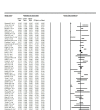Caustic Ingestion in Children: a Systematic Review and Meta-Analysis
- PMID: 27757390
- PMCID: PMC5045959
- DOI: 10.15171/jcs.2016.027
Caustic Ingestion in Children: a Systematic Review and Meta-Analysis
Abstract
Introduction: Caustic ingestion that occurs accidently is one of the most common problems in children. Methods: This systematic review has been performed by searching the databases including Science Direct, ProQuest, Google Scholar, and PubMed. A strategic search was performed with keywords including caustic, corrosive, ingestion, and children, and was limited to articles in English and Persian. Data were analyzed using Comprehensive Meta-Analysis2 and PASW Statistics 18. Results: We selected 64 articles regarding caustic ingestion with a total sample of 11,345 cases. The data analysis indicated a higher consumption in young boys (age range 2.78 (2.02) years (OR=0.53 with a 95% confidence interval of 0.49-0.57 (P=0.08)). The most common caustic substances were household cleaning agents, particularly bleaches and cleaners. Esophageal cancer and death were reported as well as digestive and respiratory complications. Invasive and expensive techniques are frequently used for diagnosis, treatment and follow up. Conclusion: The results demonstrated that although caustic ingestion is a serious problem among children, it is a preventable and manageable issue. Therefore, appropriate efforts by families, government, factories, health team and media should be made to handle adequately this matter.
Keywords: Caustic ingestion; Children; Meta-Analysis; Systematic review.
References
-
- Hockenberry MJ, Wilson D. Wong's Nursing Care of Infants and Children Multimedia Enhanced Version. 9th ed. United States: Mosby; 2013.
LinkOut - more resources
Full Text Sources
Other Literature Sources
Medical
Molecular Biology Databases



